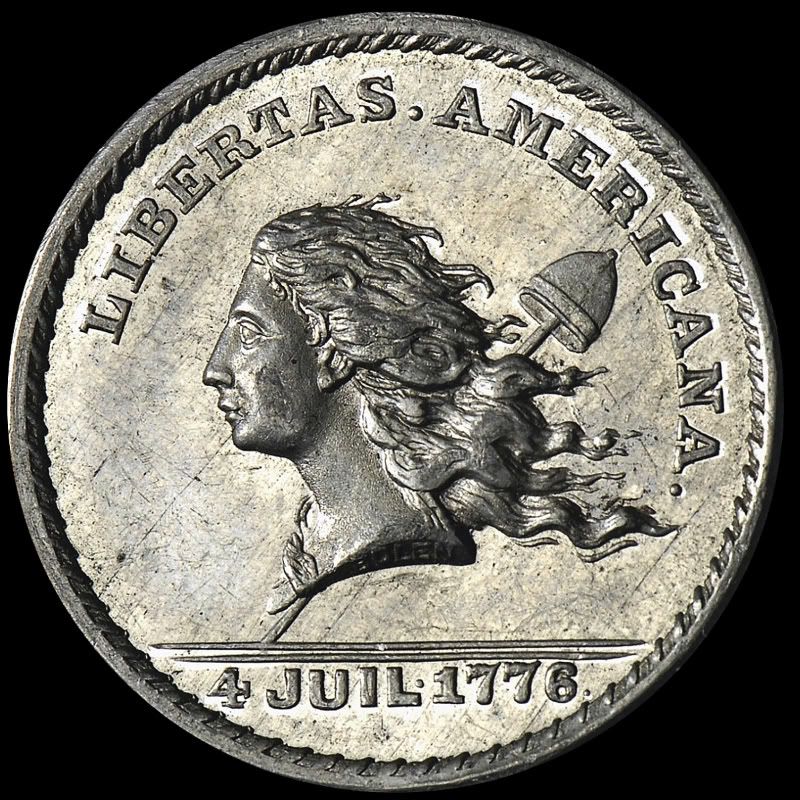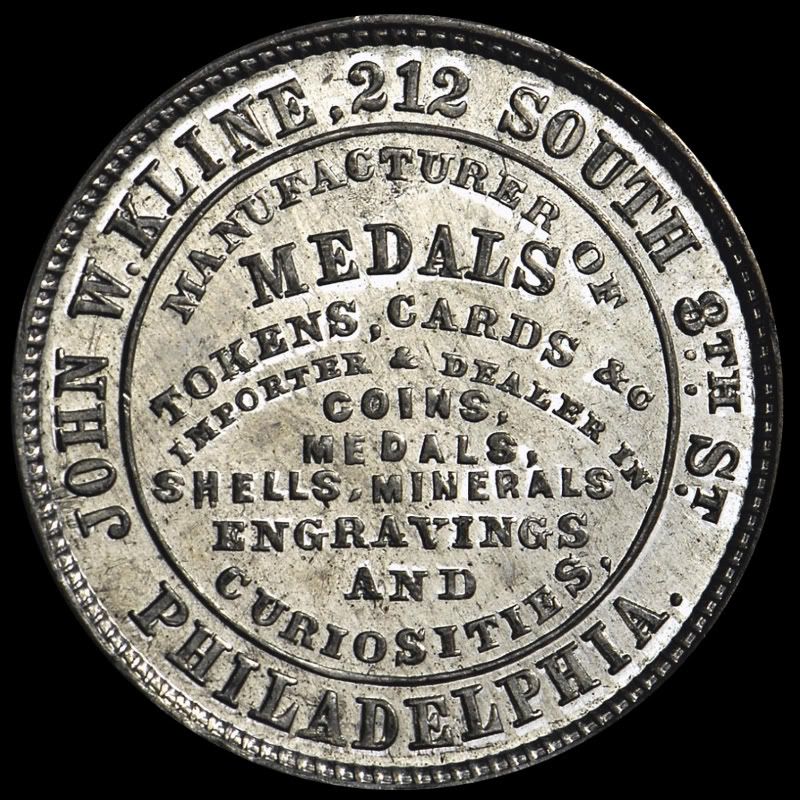Is there a difference between tin and white metal?
 coinsarefun
Posts: 21,758 ✭✭✭✭✭
coinsarefun
Posts: 21,758 ✭✭✭✭✭
If so is there a way to tell the difference.
This is a Merchant Card I won at the latest Stacks auction. The description says:
(1872) Libertas Americana / John W. Kline store card. Tin, 25.4mm, 6.4 grams. Musante JAB K-5.
It does weigh 6.4 grams. But the catalog only lists it in white metal. So is this what they meen by white metal?
The obverse die was cut by Bolen
It was From the Q. David Bowers Collection; Charles Litman Collection; Donald M. Miller Collection.


This is a Merchant Card I won at the latest Stacks auction. The description says:
(1872) Libertas Americana / John W. Kline store card. Tin, 25.4mm, 6.4 grams. Musante JAB K-5.
It does weigh 6.4 grams. But the catalog only lists it in white metal. So is this what they meen by white metal?
The obverse die was cut by Bolen
It was From the Q. David Bowers Collection; Charles Litman Collection; Donald M. Miller Collection.


CoinsAreFun Pictorials Album
.
CoinsAreFun Toned Silver Eagle Proof Album
.
Gallery Mint Museum, Ron Landis& Joe Rust, The beginnings of the Golden Dollar
.
More CoinsAreFun Pictorials NGC
.
CoinsAreFun Toned Silver Eagle Proof Album
.
Gallery Mint Museum, Ron Landis& Joe Rust, The beginnings of the Golden Dollar
.
More CoinsAreFun Pictorials NGC
0
Comments
I may be wrong.
TD
<< <i>I generally think of "white metal" as mostly tin with a small amount of alloy in it.
I may be wrong.
TD >>
Wilkipedia agrees Capt , i had a hunch you were right as i remembered looking it up before as a lot of the Chinese productions are done with various concoctions of metals described invarioubly as white metal.
White metal, otherwise refered to as pot Metal is not pure tin. Especially Banca tin. Heritage has a hard time discerning between them.
They have in the past called pieces as white metal and not tin,
Example;
Heritage archives listed this piece as white metal .. Dead wrong!
- Marcus Tullius Cicero, 106-43 BC
“It’s not aluminum or silver, so we don’t know what it is and don’t really care to find out ‘cause we have to catalog the next lot, and collectors are really stupid anyway and will just repeat ‘white metal’ and be happy.”
Pieces that have been analyzed over the past few years usually seem to be alloys of tin, but rarely pure tin.
[Banca metal is nothing more than 99.6% tin mined from alluvial deposits in Banca and nearby islands of Indonesia.]
Worry is the interest you pay on a debt you may not owe.
"Paper money eventually returns to its intrinsic value---zero."----Voltaire
"Everything you say should be true, but not everything true should be said."----Voltaire
“It’s not aluminum or silver, so we don’t know what it is and don’t really care to find out ‘cause we have to catalog the next lot, and collectors are really stupid anyway and will just repeat ‘white metal’ and be happy.”
lol, that describes me until this thread....
I knew it would happen.
Courtesy of Wikipedia.....
Cheers, RickO
tin=pure tin.
pewter=tin with a trace amount of alloy.
white metal=tin with a large amount of alloy, approaching 50%.
What is generally called, "white medal" contains some alloy, such as lead, and stands a better chance of being in some state of decent condition. Both metals are very soft and subject to wear and scratches.
My impression is that both were made “on the cheap” and were not intended to last for a long time. Certainly in the political items area white metal was for the material of choice for pieces that were to be used during the campaigns.
<< <i>As keets and others noted, anything that is ambiguously described as "white metal" should be analyzed for it's actual composition. Analysis can be performed easily and without damaging the medal or coin, and really should be part of a “grading service’s” or auction company’s objective understanding of the item. >>
I don't see this type of analysis/testing to be economically feasible except for expensive coins.
Worry is the interest you pay on a debt you may not owe.
"Paper money eventually returns to its intrinsic value---zero."----Voltaire
"Everything you say should be true, but not everything true should be said."----Voltaire
Tin: SG=7.31.
white metal = who knows. An alloy of different whitish low grade metals.
'white metal' when used to describe a coin or token translates to me as 'I'm not quite sure what to say it's made of'
Tin is pretty soft and will usually darken and tarnish so isn't used extensively for coinage. Thailand
uses it but otherwise it's not often seen. It's great in alloys though and is critical to making copper
hard as in bronze.
I don't believe tin is still allowed as a coating for steel in cans. It is toxic and highly reactive. It's not
as hazardous as zinc or lead which were used in the past but is toxic.
<< <i>In some cases "white metal" is usually copper nickel. This certainly applies to transportation tokens. >>
Add in a little zinc and you have German silver.
Worry is the interest you pay on a debt you may not owe.
"Paper money eventually returns to its intrinsic value---zero."----Voltaire
"Everything you say should be true, but not everything true should be said."----Voltaire
<< <i>In some cases "white metal" is usually copper nickel. This certainly applies to transportation tokens.
Tin is pretty soft and will usually darken and tarnish so isn't used extensively for coinage. Thailand
uses it but otherwise it's not often seen. It's great in alloys though and is critical to making copper
hard as in bronze.
I don't believe tin is still allowed as a coating for steel in cans. It is toxic and highly reactive. It's not
as hazardous as zinc or lead which were used in the past but is toxic. >>
So does the token above appear to be tin or white metal.
The description says tin, but there is no listing for tin, only white metal.
I have heard about this exact token being struck in tin but thought to be only one or two made.
Also, I would assume coming from the collection such as Q.D.Bowers he would have made a point to see if
its tin? Because if it is tin then its one of only a few.
Maybe when I submit to NGC I can ask them to decipher if its tin or white metal?
The image is from Stacks, in hand it is very grey looking and the fields are very reflective.
That makes me thinks it white metal or possibly aluminum?
.
CoinsAreFun Toned Silver Eagle Proof Album
.
Gallery Mint Museum, Ron Landis& Joe Rust, The beginnings of the Golden Dollar
.
More CoinsAreFun Pictorials NGC
<< <i>
So does the token above appear to be tin or white metal.
The description says tin, but there is no listing for tin, only white metal.
I have heard about this exact token being struck in tin but thought to be only one or two made.
>>
I can't answer your questions but tin is much heavier than aluminum. If it's heavy it's not aluminum.
<< <i>
<< <i>
So does the token above appear to be tin or white metal.
The description says tin, but there is no listing for tin, only white metal.
I have heard about this exact token being struck in tin but thought to be only one or two made.
>>
I can't answer your questions but tin is much heavier than aluminum. If it's heavy it's not aluminum. >>
That's what I always thought, aluminum is much lighter in weight than tin.......so I don't know what
Metal it is. The only thing I can think of is to have NGC test or tell me what it is.
Thanks cladking and everyone else for there input
.
CoinsAreFun Toned Silver Eagle Proof Album
.
Gallery Mint Museum, Ron Landis& Joe Rust, The beginnings of the Golden Dollar
.
More CoinsAreFun Pictorials NGC
Then I post this coin on the darkside
And find out this from board member Sapyx:
Actually, these are made of a billon alloy known as "potin" - nominally a small amount of silver, but alloyed with a large amount of whatever scrap metal was lying around - copper, iron, tin, lead, whatever. Potin coins generally do not preserve well, and are more susceptible than ordinary copper, bronze or brass to corrosion; we only have plenty of these coins surviving today because of Egypt's relatively dry, stable climate.
Who woulda known...
Amazing the knowledge of some and the never ending search for knowledge by others (like me)
Video